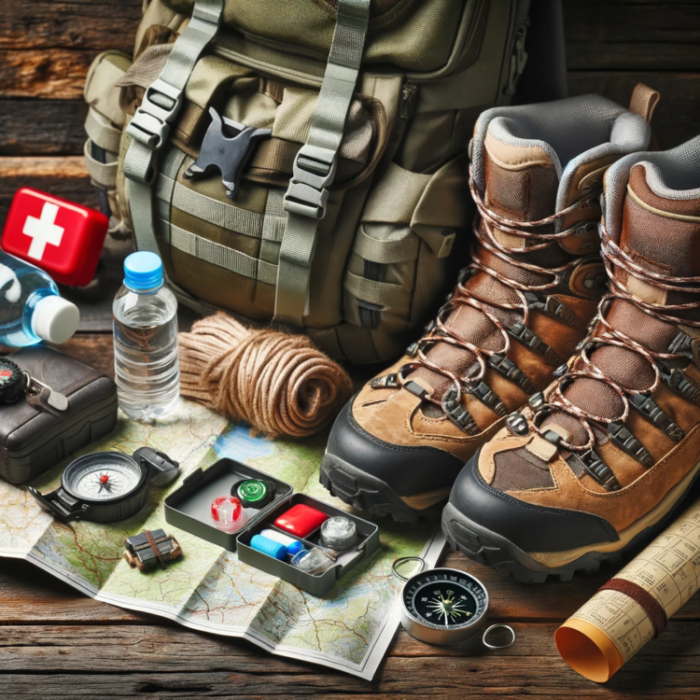Table of Contents

Introduction: Embracing the Trail
Hiking essentials as gear, proper clothes, food and water, are the difference between an enjoyable day to a possible nightmare. Embarking on your first hiking adventure marks the beginning of a journey into the heart of nature, a pursuit that can be as enriching as it is challenging. This comprehensive guide aims to demystify the process for beginners, providing crucial tips and gear recommendations. Whether you’re drawn to the serene beauty of forest trails or the rugged allure of mountain paths, this guide will help you start your hiking journey with confidence and enjoyment.
Hiking Basics: Preparation and Awareness
Understanding Your Trail: The first step in your hiking adventure is selecting an appropriate trail. As a beginner, it’s important to choose trails that match your current fitness level and hiking experience. Utilize online resources, hiking forums, and apps to gather information about trail length, elevation gain, terrain type, and user reviews. This research will not only help you find a trail that’s enjoyable but also ensure you’re adequately prepared for its specific challenges.
Starting Off Easy:
Hiking, like any other physical activity, requires building up your endurance and skill level gradually. Begin with shorter, less challenging trails. These initial hikes will allow you to understand your physical limits and preferences in various terrains and conditions. As you gain confidence and strength, you can gradually increase the difficulty and length of your hikes.
Weather Awareness:
Weather plays a pivotal role in hiking. Unexpected weather changes can transform a trail’s difficulty and potentially create hazardous conditions. Always check the weather forecast before your hike and prepare for possible changes in weather. Understanding weather patterns and how they affect different terrains will become an invaluable part of your hiking knowledge.
Hiking Essentials for begginers: Investing in Comfort and Safety

Choosing the Right Footwear:
The importance of high-quality hiking boots or shoes cannot be overstated. Your footwear should provide support, comfort, and protection against various terrains. Look for waterproof, breathable materials, good grip, and ankle support. Breaking in your hiking footwear with short walks or around your home before hitting the trail can prevent blisters and discomfort.
Selecting a Suitable Backpack:
A well-fitted backpack is crucial for carrying your essentials comfortably. Look for backpacks with padded shoulder straps, a hip belt, and multiple compartments for easy organization. The size of your backpack should correspond to the length and nature of your hikes. Day hikes require smaller packs, while overnight or longer treks need larger, more robust backpacks.
Appropriate Clothing Choices:
Layering is key in hiking attire. Start with a moisture-wicking base layer, add an insulating layer, and top it off with a waterproof and windproof outer layer. This system allows you to adapt to changing temperatures and conditions. Avoid cotton as it retains moisture and can lead to hypothermia in cooler conditions. Opt for synthetic or wool fabrics instead.
Packing Essentials: What to Bring on Your Hike
Hydration Strategies:
One of hiking essentials. Dehydration is a common and dangerous issue on hikes. Carry ample water – a general rule is half a liter per hour of moderate activity in moderate temperatures. In hotter climates or more strenuous trails, increase this amount. Hydration systems like bladders are convenient for drinking on the go, while water bottles are easier to refill and manage.
Nutritional Needs
High-energy, lightweight snacks are essential for maintaining your energy levels on the trail. Nuts, seeds, dried fruits, energy bars, and jerky are excellent choices. For longer hikes, pack a nutritious lunch that includes a balance of carbohydrates, proteins, and fats. Remember, food is not just fuel; it’s also a morale booster during challenging stretches.
Navigation Tools for Safety:
While many trails are well-marked, having a map and compass or a GPS device are main hiking essentials for safety. Learning basic navigation skills can be a lifesaver in situations where technology fails or trails are poorly marked. These tools become even more crucial in remote or less-traveled areas.
First Aid Essentials:
A well-stocked first aid kit should include bandages, antiseptic wipes, blister prevention and treatment supplies, pain relievers, and any personal medications. Familiarize yourself with the basic first aid procedures for common hiking injuries and illnesses.
Trail Safety and Etiquette: Coexisting with Nature
Trail Respect:
Staying on marked trails is crucial for both your safety and the preservation of the natural environment. Venturing off-trail can lead to erosion, disturb wildlife, and increase your risk of getting lost.
Leave No Trace Principles:
One of the core tenets of hiking is the ‘Leave No Trace’ ethic. Pack out all trash, leave what you find, and respect wildlife and fellow hikers. This approach ensures the trails and natural areas remain pristine for future visitors.
Wildlife Encounters:
Understanding how to behave around wildlife is crucial. Research the types of wildlife you might encounter and learn how to respond in their presence. The key is to observe from a distance, not to feed or approach them, and to know what to do in an unlikely encounter with a potentially dangerous animal.
Conclusion: The Reward of the Trail
As you embark on your hiking journey, remember that each step is an opportunity to learn, grow, and connect with the natural world. Hiking essentials are as important as the journey it self. With the right preparation, gear, and respect for nature, you’re ready to explore the trails and discover the unique joys and challenges that await in the great outdoors. Happy hiking!
And as an outdoor lover, you should check our last blog about “THE 8 REASONS TO CHOOSE OUTDOOR FITNESS IN 2024“. And always, thank you for visiting.